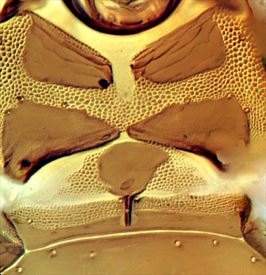Thrips of New Zealand
Distinguishing features
Female fully winged or micropterous. Body pale brown, tarsi and antennal segment III almost yellow, tibiae pale on inner margin and at base; major setae brown, anal setae darker; fore wings brown in distal two-thirds. Head longer than wide, faintly sculptured near base; cheeks rounded, constricted at base; ocelli small; compound eyes larger dorsally than ventrally; postocular setae about half as long as eye, blunt or slightly expanded at apex; maxillary stylets wide apart, retracted almost to postocular setae; maxillary bridge present. Antennae 8-segmented; segment III with 2 sense cones, IV with 2 (often plus an extra smaller one). Pronotum elongate, with bluntly pointed setae, epimeral and posteroangular setae longest. Mesopresternum boat-shaped, not eroded. Metathoracic sternopleural sutures absent. Fore tarsal tooth small. Fore wing wider at base, with 3 bluntly pointed major sub-basal setae, S1 longest, no duplicated cilia. Pelta 'D'-shaped, sculptured; tergites III–VII each with 2 pairs of sigmoid wing-retaining setae; tergite VIII with posteroangular setae finely pointed, posteromarginal setae blunt; tergite IX posteromarginal setae S1 and S2 subequal, finely pointed, nearly as long as tube; tube shorter than head. Female microptera with wing lobe variable in length, often bearing 3 bluntly pointed sub-basal setae; tergites with sigmoid wing-retaining setae.
Male microptera. Similar to female, but smaller, with wing-retaining setae sometimes not sigmoid or even absent.
Related species
The genus Haplothrips comprises 240 described species worldwide, of which only four are recorded from New Zealand, and none of these seems to be endemic. H. collyerae, described originally in Apterygothrips, is unusual in having only two major sense cones on antennal segment IV (sometimes with an additional small one).
Biological data
Widely collected from both living and dead plant material, and apparently predatory on a wide range of mites or other small arthropods, this species is recorded as a predator of Sericothrips staphylinus in Tasmania (Mound & Minaei, 2007).
Distribution data
Described from New Zealand, where it is widespread (ND, AK, WO, BP, TO, WI / SD, NN, KA, BR, WD, MK, CO, SL), this species is also established in Tasmania, thus it is not neccesarily endemic to New Zealand.
Family name
PHLAEOTHRIPIDAE, PHLAEOTHRIPINAE
Species name
Haplothrips collyerae (Mound & Walker)
Original name and synonyms
Apterygothrips collyerae Mound & Walker, 1986: 40
References
Mound LA & Minaei K (2007) Australian insects of the Haplothrips lineage (Thysanoptera – Phlaeothripinae). Journal of Natural History 41: 2919–2978.
Mound LA & Walker AK (1986) Tubulifera (Insecta: Thysanoptera). Fauna of New Zealand 10: 1–140.



